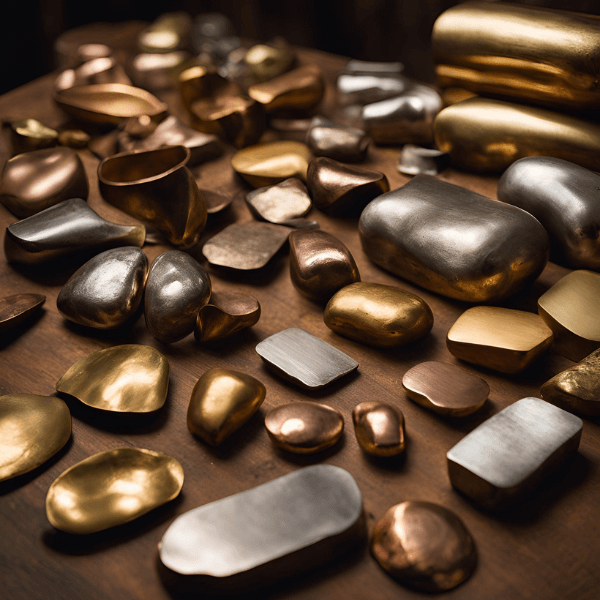6 min read
3D Printing and Nanotechnology
3D printing and nanotechnology are two fields of research and innovation that, at first glance, might appear worlds apart. The former focuses on...
4 min read
![]() Weerg staff
:
Oct 14, 2024
Weerg staff
:
Oct 14, 2024

Soft metals are a category of metallic materials characterized by high malleability and ductility, making them easy to work with through mechanical deformation processes such as rolling, drawing, and stamping. Unlike harder or more resistant metals, soft metals can be shaped under relatively low forces, making them ideal for a wide range of industrial applications. Common soft metals include lead, aluminum, tin, and gold, as well as alloys such as copper, bronze, and brass, each with unique technical characteristics and applications.
Soft metals are distinguished by their low hardness, making them easily workable. The main mechanical properties of soft metals include:
Malleability: The ability to be worked into thin sheets without breaking.
Ductility: The ability to be stretched into thin wires without fracturing.
Low melting point: Most soft metals have relatively low melting points, which facilitates their melting and processing in liquid form.
Thermal and electrical conductivity: Some soft metals, such as copper and aluminum, are excellent conductors of heat and electricity, making them ideal for electrical applications.
There are significant differences between various soft metals in terms of atomic structure, mechanical and chemical behaviour, and specific applications. Below is an overview of some of the most important:

Aluminium (Al): Lightweight, highly resistant to corrosion, and easily workable. While relatively soft, aluminum can be strengthened through cold working or alloying. It is widely used in aerospace, automotive applications, and packaging production, such as cans and foils.
Lead (Pb): Extremely ductile and malleable, lead also has high density, making it ideal for radiation shielding and use in lead-acid batteries. Its toxicity has limited its use in many modern applications, but it remains important in certain industrial niches.
Tin (Sn): With a low melting point and good corrosion resistance, tin is commonly used as a protective coating for other metals, especially steel and copper (in the process of tinning). It is also a key component of soldering alloys due to its softness and ease of processing.
Gold (Au): Known for its malleability and ductility, as well as its resistance to corrosion and high electrical conductivity, gold is essential in the electronics industry for high-reliability contacts and circuits. Gold is also widely used in jewelry and as an economic store of value.
Copper (Cu): Copper is a highly important soft metal for industrial use due to its excellent electrical and thermal conductivity, second only to silver. It is widely used in electrical wiring, electronic components, and plumbing. Although relatively soft, copper can be cold-worked to increase its hardness. Additionally, copper has notable corrosion resistance, especially in non-acidic environments, and forms a protective oxide layer (patina) that further slows deterioration.

Bronze: Bronze is an alloy primarily composed of copper and tin, with small percentages of other elements like zinc, nickel, or phosphorus. Although copper is a soft metal, the addition of tin significantly improves its hardness and mechanical strength, making bronze a more resistant and durable alloy compared to pure copper. Bronze has excellent corrosion resistance, especially in marine environments, and is used for producing gears, valves, pumps, and artistic works such as sculptures and medals.
Brass: Brass is an alloy of copper and zinc, where the amount of zinc directly affects the alloy's properties. The higher the zinc content, the greater the mechanical strength and hardness of the brass, though it slightly reduces ductility and malleability. Brass is widely used for its workability and corrosion resistance. It is used in applications such as hydraulic fittings, musical instrument components, coins, and architectural decorations.
Soft metals and their alloys, such as aluminum, copper, bronze, and brass, are widely used in CNC (Computer Numerical Control) machining due to their ease of processing and excellent response to machine tools. CNC machining allows for the production of complex, precise components with tight tolerances, minimizing waste and optimizing production times. Due to their malleability, soft metals are particularly well-suited to processes like milling, turning, and drilling, producing high-quality surfaces without requiring extensive corrective interventions.
Aluminium: The most commonly used soft metal in CNC machining due to its combination of lightness, ease of cutting, and corrosion resistance. Its machinability makes it ideal for producing lightweight yet strong structural and mechanical components used in sectors like aerospace and automotive.
Copper: With its excellent electrical and thermal conductivity, copper is widely used in CNC machining for electrical and thermal components such as heat sinks, connectors, and circuits. Its malleability allows for the easy production of intricate, complex parts.
Bronze and Brass: These copper alloys are ideal for CNC machining due to their strength and dimensional stability. Brass, with its easy workability and shiny finish, is widely used for fittings, valves, and decorative elements, while bronze is chosen for mechanical applications such as bearings and gears, thanks to its wear resistance.
CNC machining of soft metals offers high precision, reducing production times and costs, making these alloys ideal for mass production and high-performance industrial applications.


The term "soft" refers to the ease with which these metals can be deformed under mechanical loads. At the atomic level, soft metals have crystal structures that allow easy dislocation movement, meaning the shifting of atomic planes under force. This phenomenon is more apparent in metals with less rigid atomic bonds and crystal structures that allow greater atomic movement, making them more "malleable."
Thanks to their combination of ductility, malleability, and other favorable properties, soft metals and their alloys find application in many industrial sectors:
Wires and electrical components: Copper and gold, thanks to their high electrical conductivity, are essential for producing electrical wires, printed circuits, and electrical contacts.
Pipes and plumbing: Copper is widely used for plumbing and heating systems due to its corrosion resistance and ease of processing.
Naval construction: Bronze, resistant to corrosion in marine environments, is used for valves, pumps, and structural components in the naval sector.
Musical instruments: Brass is used for constructing wind instruments due to its easy machinability and acoustic properties.
Jewelry and decorations: Gold and copper are widely used in producing jewelry and decorations due to their aesthetics and ease of processing.
The recycling of soft metals is a key factor for environmental sustainability. Metals like copper and aluminum can be recycled almost indefinitely without losing their properties, thus reducing the need for mining and the associated environmental impacts. Additionally, producing new aluminum from scratch has high energy consumption, particularly electrical, making the production of "new" metal very environmentally impactful. Alloys such as bronze and brass are efficiently recovered and remelted, reducing the use of primary resources and contributing to a more sustainable production cycle.

Soft metals, along with copper-based alloys like bronze and brass, represent a fundamental category of metallic materials thanks to their unique combination of malleability, ductility, and other favourable mechanical properties. These metals and their alloys are indispensable for many industries, from electronics to construction, from mechanics to jewelry. Continued innovations in production, CNC machining, and recycling of these materials will ensure their importance for future generations, contributing to increasingly efficient and sustainable solutions.

6 min read
3D printing and nanotechnology are two fields of research and innovation that, at first glance, might appear worlds apart. The former focuses on...

6 min read
Padel has seen exponential growth in Italy and worldwide in recent years. A glance at sports clubs in major cities and smaller towns alike reveals an...

6 min read
The game of chess boasts a history spanning millennia, seamlessly merging art, strategy, and culture into a singular experience that has captivated...